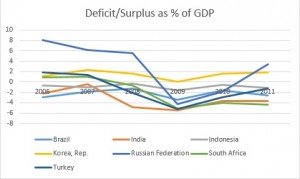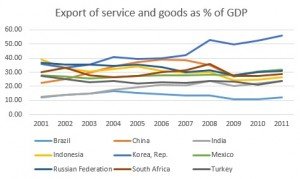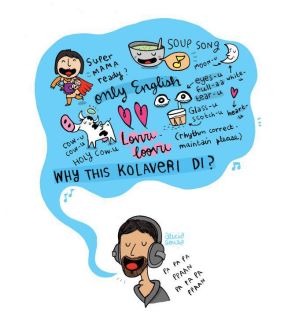|
Country Name
|
2006
|
2007
|
2008
|
2009
|
2010
|
2011
|
|
Brazil
|
-2.88
|
-1.87
|
-1.21
|
-3.47
|
-1.67
|
-2.58
|
|
India
|
-2.24
|
-0.47
|
-4.87
|
-5.42
|
-3.64
|
-3.68
|
|
Indonesia
|
-0.62
|
-1.02
|
-0.34
|
-1.67
|
-0.56
|
-1.14
|
|
Korea, Rep.
|
1.14
|
2.32
|
1.64
|
0.02
|
1.65
|
1.82
|
|
Russian Federation
|
8.02
|
6.19
|
5.62
|
-4.21
|
-1.91
|
3.37
|
|
South Africa
|
0.91
|
1.08
|
-0.68
|
-5.14
|
-4.04
|
-4.35
|
|
Turkey
|
1.90
|
1.41
|
-2.15
|
-5.25
|
-2.92
|
-1.29
|

|
Country Name
|
2006
|
2007
|
2008
|
2009
|
2010
|
2011
|
|
Brazil
|
55.75
|
57.39
|
56.63
|
60.00
|
52.21
|
52.79
|
|
India
|
59.11
|
56.48
|
56.11
|
54.31
|
50.43
|
48.50
|
|
Indonesia
|
38.93
|
35.18
|
33.14
|
28.36
|
26.10
|
26.22
|
|
Russian Federation
|
9.89
|
7.16
|
6.50
|
8.70
|
9.33
|
9.52
|
|
Turkey
|
51.50
|
44.35
|
44.66
|
53.56
|
50.94
|
45.92
|
|
Country Name
|
2001
|
2002
|
2003
|
2004
|
2005
|
2006
|
2007
|
2008
|
2009
|
2010
|
2011
|
|
Brazil
|
12.18
|
14.10
|
14.99
|
16.43
|
15.13
|
14.37
|
13.36
|
13.66
|
10.98
|
10.87
|
11.89
|
|
China
|
22.60
|
25.13
|
29.56
|
33.95
|
37.08
|
39.13
|
38.41
|
34.98
|
26.71
|
30.61
|
31.37
|
|
India
|
12.38
|
14.05
|
14.71
|
17.55
|
19.28
|
21.07
|
20.43
|
23.60
|
20.05
|
21.94
|
23.88
|
|
Indonesia
|
39.03
|
32.69
|
30.48
|
32.22
|
34.07
|
31.03
|
29.44
|
29.81
|
24.16
|
24.62
|
26.33
|
|
Korea, Rep.
|
35.74
|
33.13
|
35.37
|
40.88
|
39.27
|
39.68
|
41.92
|
53.01
|
49.73
|
52.28
|
56.16
|
|
Mexico
|
27.56
|
26.82
|
25.35
|
26.61
|
27.10
|
27.97
|
27.93
|
28.05
|
27.72
|
30.31
|
31.67
|
|
Russian Federation
|
36.89
|
35.25
|
35.25
|
34.42
|
35.20
|
33.73
|
30.16
|
31.31
|
27.94
|
29.95
|
31.05
|
|
South Africa
|
30.13
|
32.92
|
27.88
|
26.42
|
27.38
|
30.01
|
31.29
|
35.79
|
27.40
|
27.34
|
28.82
|
|
Turkey
|
27.44
|
25.22
|
22.99
|
23.55
|
21.86
|
22.67
|
22.32
|
23.91
|
23.32
|
21.21
|
23.74
|

|
Country
|
GDP in 2050 (in billion USD)
|
|
Brazil
|
11,366
|
|
Russia
|
8,580
|
|
India
|
37,668
|
|
China
|
70,710
|
|
Total
|
128,324
|
|
Mexico
|
9,340
|
|
Indonesia
|
7,010
|
|
Korea,Rep
|
4,083
|
|
Turkey
|
3,943
|
|
Total
|
24,376
|
You might like reading:

From Kolaveri to Dancing Matt: The power of Viral marketing
The latest craze on the social networking sites, is this song from Tamil film star Dhanush called’ Why this Kolaveri Di’. The song has more than 1.5 million downloads and is a rage all across the globe from Bhangra parties in Birmingham to Andhra get-togethers in New Jersey. Not to forget in my own home town of Delhi, the song […]

Sustainability and restoring nature was the biggest drive: Swastika Mukherjee, The Leaf Story
Most individuals strive in search for a collective to just have their voices heard to the society. Here is an individual who single handedly takes her own strides and has reached a level of working and execution where most of us dream for. Swastika Mukherjee has gone through a long journey from designing terrariums to saving plastic penetration in our […]































